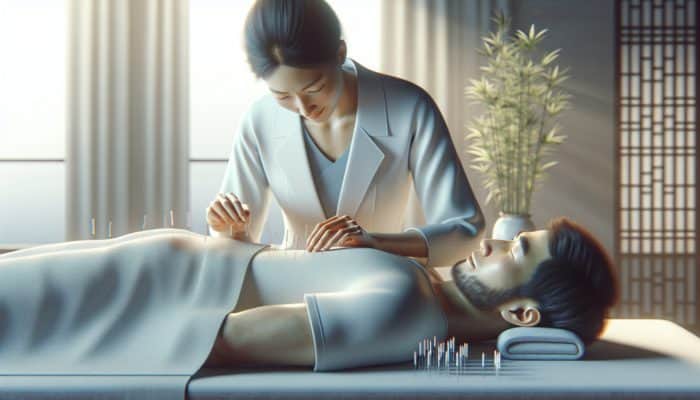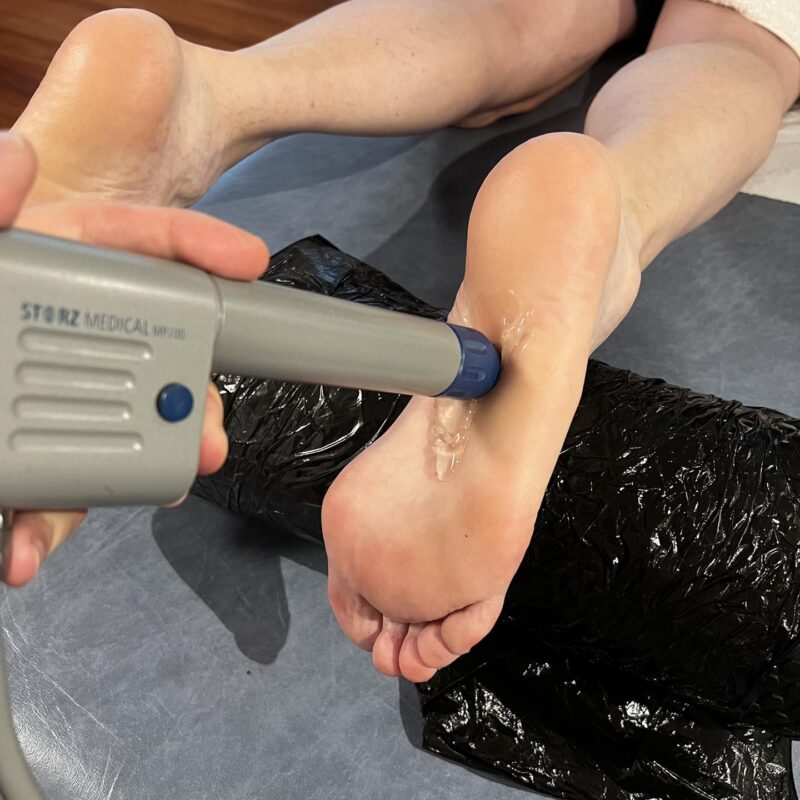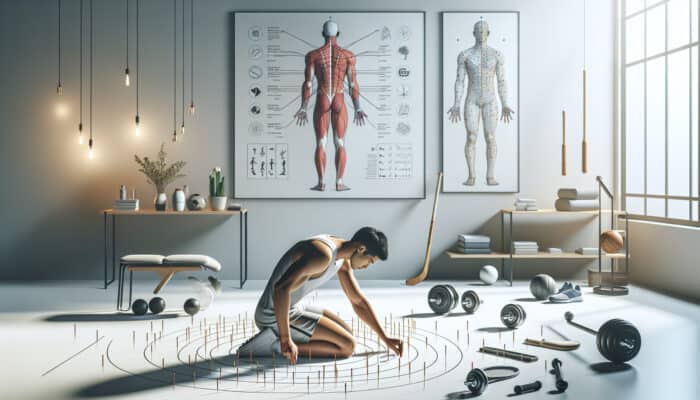Comprehensive Guide to Acupuncture in the UK
Exploring the Historical Journey of Acupuncture in the UK

Acupuncture for Knee Pain Relief: Acupuncture boasts a rich and historical legacy in the United Kingdom, with its origins tracing back to the late 20th century, when it garnered growing interest from both medical professionals and the general public. Initially introduced as an alternative remedy, acupuncture has since evolved into a well-recognised and widely accepted treatment modality, embraced by numerous practitioners within the healthcare community. As skilled acupuncturists made significant strides in educating the public on the myriad benefits of this ancient practice, a notable shift occurred, with more individuals seeking acupuncture for a variety of ailments, particularly for chronic pain conditions such as knee pain.
The integration of acupuncture into traditional healthcare systems marked a significant turning point in its acceptance. By the early 2000s, acupuncture transitioned to a more mainstream practice, supported by a plethora of studies that showcased its efficacy. The establishment of dedicated acupuncture clinics in major cities, such as London and Manchester, further exemplified this growing acceptance, leading to a notable increase in qualified practitioners across the country. This period of growth not only reflected the public’s increasing trust in acupuncture but also highlighted its potential to complement conventional medical treatments.
In contemporary healthcare settings, acupuncture is frequently recommended by professionals as a complementary treatment, demonstrating its versatility in addressing a wide range of health concerns. Its steady rise in popularity signifies a broader cultural shift towards holistic and integrative approaches to health and wellness within the UK, as more individuals seek natural and effective solutions for their health challenges.
Key Regulatory Bodies Overseeing Acupuncture Practices
In the UK, the practice of acupuncture is governed by several regulatory bodies committed to ensuring the safety and professionalism of practitioners. The British Acupuncture Council (BAcC) stands out as one of the primary regulatory organisations, boasting a substantial membership of thousands of acupuncturists. The BAcC establishes stringent standards for training, practice, and ethical conduct, ensuring that all practitioners are well-equipped to provide quality care to their patients.
Moreover, the Complementary and Natural Healthcare Council (CNHC) plays a crucial role in regulating complementary therapies, including acupuncture. This organisation is dedicated to promoting high standards of practice while prioritising patient safety. Both the BAcC and the CNHC require acupuncturists to undergo rigorous training, adhere to a comprehensive code of conduct, and engage in continuous professional development, thereby fostering trust in the practice among patients seeking treatment.
The regulatory framework not only enhances the credibility of acupuncture as a treatment option but also provides reassurance to patients that they are receiving care from qualified professionals. This oversight is particularly important in promoting acupuncture as a viable choice for managing conditions such as knee pain, as patients increasingly seek reliable and effective treatments for their health issues.
Pathway to Becoming a Certified Acupuncturist
To become a qualified acupuncturist in the UK, an extensive training and certification process is required. Most aspiring practitioners begin their journey by enrolling in accredited programmes that cover both the theoretical and practical aspects of acupuncture. These comprehensive courses typically last between three and four years and culminate in the attainment of a degree or diploma accredited by recognised organisations such as the BAcC.
The curriculum encompasses an in-depth study of human anatomy, physiology, and the foundational principles of Traditional Chinese Medicine (TCM). Aspiring acupuncturists learn the intricate art of needling, alongside various techniques designed to treat specific conditions, including knee pain. Furthermore, training encompasses patient assessment and safety protocols, ensuring practitioners are proficient in providing safe and effective treatments.
Once their training is complete, practitioners are required to register with a professional body, often involving the successful completion of a competency exam. This certification process is essential, as it assures patients of the practitioner’s expertise and professionalism, ultimately enhancing the reputation of acupuncture as a credible treatment modality within the UK.
Emerging Trends in Acupuncture Utilisation

Currently, acupuncture is experiencing a renaissance in the UK, characterised by a notable surge in its popularity across diverse demographics. Many patients are increasingly exploring acupuncture as a holistic approach to managing pain, particularly for conditions such as knee pain. The growing awareness surrounding chronic pain, coupled with the limitations of conventional treatments, has prompted more individuals to seek alternative therapies, with acupuncture frequently at the forefront of these options.
Recent trends reveal an increasing acceptance of acupuncture among younger generations, who prioritise wellness and preventive care. Many are turning to acupuncture not just for pain relief, but also for stress reduction and overall well-being. Clinics in urban areas are adapting to these trends by offering personalised treatment plans tailored to the specific needs of their clients, often integrating acupuncture with other complementary therapies for enhanced efficacy.
Additionally, the growing number of studies highlighting the effectiveness of acupuncture for various ailments has bolstered its credibility within mainstream healthcare. This cultural shift is reshaping the landscape of pain management in the UK, positioning acupuncture as a preferred option for many individuals grappling with knee pain and other chronic conditions.
Assessing the Benefits and Risks Associated with Acupuncture
Like any treatment modality, acupuncture presents both potential benefits and risks that UK patients should consider carefully. Among the most significant advantages, acupuncture for knee pain relief stands out prominently. Numerous patients report substantial reductions in pain levels, enhanced joint mobility, and an overall improvement in their quality of life. The treatment operates by stimulating specific acupuncture points, prompting the release of endogenous endorphins, which are the body’s natural pain-relieving hormones.
Furthermore, acupuncture is generally well-tolerated, with most individuals experiencing minimal side effects, often limited to slight bruising or tenderness at the needle insertion sites. Nevertheless, it is crucial to acknowledge the potential risks associated with the treatment, particularly if administered by an unqualified practitioner. Improper techniques can lead to adverse effects, including infections or injury.
To ensure a safe experience, patients should always seek treatment from accredited acupuncturists registered with a professional body. By doing so, they can enjoy the numerous benefits of acupuncture while minimising the risks associated with this ancient yet effective healing practice, thereby fostering confidence in their chosen treatment.
Exploring the Specific Benefits of Acupuncture for Knee Pain
Understanding Pain Reduction Mechanisms Through Acupuncture

When it comes to alleviating knee pain, acupuncture operates on a fascinating premise that intertwines both ancient tradition and modern science. The treatment involves the insertion of fine needles into specific points on the body, corresponding to energy pathways, or meridians, as defined in Traditional Chinese Medicine. This stimulation can trigger the body’s natural healing processes, leading to a significant reduction in pain and inflammation in the affected knee.
Research indicates that acupuncture can effectively modulate pain perception by influencing the central nervous system. For example, needling certain acupuncture points can promote the release of neurotransmitters such as serotonin and dopamine, both of which play vital roles in regulating pain. This biochemical response not only aids in alleviating immediate discomfort but may also contribute to long-term pain relief, making acupuncture an appealing option for individuals suffering from chronic knee pain.
Moreover, acupuncture can enhance blood circulation around the knee joint. Improved blood flow facilitates the delivery of oxygen and essential nutrients to the tissues, promoting healing and reducing stiffness. Many patients report experiencing immediate relief following a session, underscoring the effectiveness of acupuncture as a practical solution for managing knee pain and enhancing overall mobility.
Enhancing Mobility and Function Through Acupuncture
One of the remarkable benefits of acupuncture lies in its ability to improve mobility and overall function in patients experiencing knee pain. Many individuals struggle with a reduced range of motion due to pain or stiffness, which can severely hinder daily activities and diminish their quality of life. Acupuncture serves as a valuable ally in restoring that much-needed mobility.
Through targeted treatments, acupuncture helps to relax tense muscles surrounding the knee and alleviate inflammation. This relaxation can lead to improved flexibility and joint function, allowing patients to perform movements that may have been previously painful or impossible. Many practitioners employ a combination of acupuncture and gentle mobilisation techniques to enhance mobility further, tailoring the treatment to meet individual patient needs effectively.
Additionally, the psychological benefits of acupuncture should not be overlooked. Patients frequently report an improved sense of well-being and reduced stress levels following treatment, which can have a positive ripple effect on their overall physical function. This holistic approach to knee pain management not only addresses the physical symptoms but also promotes a sense of empowerment and resilience, encouraging patients to regain control over their movements and activities.
Exploring Long-term Relief and Management Strategies
For individuals suffering from chronic knee pain, the prospect of long-term relief can often seem elusive. However, regular acupuncture treatments may provide a viable solution for managing pain effectively. Many patients who incorporate acupuncture into their care regimen discover that ongoing sessions help maintain their pain relief, enabling them to manage their condition more effectively over time.
Acupuncture promotes a proactive approach to managing knee pain, addressing the underlying causes rather than merely masking symptoms. By stimulating the body’s natural healing processes, acupuncture can help reduce the frequency and severity of pain episodes over time. As patients continue their treatment journey, they often report a gradual decrease in the intensity of their knee pain, allowing them to engage more fully in life and enjoy activities they previously avoided.
Moreover, the cumulative effect of regular acupuncture treatments can lead to enhanced mobility, improved function, and a greater overall sense of well-being. This long-term benefit is particularly appealing for individuals seeking to avoid more invasive procedures or reliance on pain medications, which may carry their own set of complications. As more people in the UK explore acupuncture as a long-term strategy for managing knee pain, the potential for improved quality of life becomes increasingly attainable.
Accessing Acupuncture Services Across the UK
Guidelines for Locating Qualified Acupuncturists
Embarking on the journey to find a qualified acupuncturist in the UK can be daunting, especially when seeking treatment for specific conditions such as knee pain. The key to a successful search is to conduct thorough research and ensure that the practitioner you choose meets the necessary qualifications and standards.
Begin by visiting the British Acupuncture Council (BAcC) website, which offers a comprehensive directory of accredited practitioners. This invaluable resource not only assists you in locating qualified practitioners but also provides insights into their areas of specialisation, ensuring that you select someone with experience in treating knee pain.
Furthermore, personal recommendations can prove to be invaluable; if you know friends or family members who have had positive acupuncture experiences, do not hesitate to ask them for referrals. Online reviews and testimonials can further enrich your search, offering firsthand insights into the experiences of other patients. A practitioner’s approach to patient care, communication style, and the overall atmosphere of their clinic can significantly influence your treatment experience.
Taking the time to research and find a qualified acupuncturist can ensure that you receive effective and safe treatment for knee pain, guiding you on a path toward recovery and improved well-being.
Exploring NHS and Private Acupuncture Options
In the UK, patients seeking acupuncture for knee pain can opt for NHS services or private clinics. Understanding the distinctions between these pathways is essential for making informed decisions regarding your healthcare options.
NHS acupuncture services are often limited to specific conditions and may not be available in every region. Availability can vary significantly, and waiting times for appointments can be lengthy. However, patients eligible for treatment may find that NHS-accredited acupuncturists adhere to strict guidelines and protocols, ensuring high standards of care throughout the treatment process.
Conversely, private acupuncture clinics offer greater flexibility in terms of appointment scheduling and treatment options. Many practitioners in private settings provide a broader array of services, including specialised treatments tailored specifically for knee pain. Although private acupuncture may incur higher costs, many patients find the associated benefits—such as shorter wait times and personalised treatment plans—worth the investment.
Ultimately, the choice between NHS and private acupuncture services depends on individual circumstances, including financial considerations and personal preferences regarding treatment style. Regardless of the chosen route, the primary goal remains the same: to find effective relief from knee pain through the expertise of skilled acupuncture practitioners.
Understanding Patient Reviews and Testimonials
Reading patient reviews and testimonials can play a pivotal role in selecting the right acupuncture service for knee pain in the UK. These personal accounts offer valuable insights into the experiences of others, enabling potential patients to assess the efficacy and professionalism of various practitioners.
Many patients share their stories of relief from chronic pain and improved mobility following acupuncture sessions. Positive testimonials often highlight the acupuncturist’s expertise, the calming atmosphere of the clinic, and the overall effectiveness of the treatment received. Such narratives can instil greater confidence in prospective patients when choosing a practitioner, especially when they resonate with similar experiences or challenges faced.
Conversely, it is equally important to consider negative reviews, as they may reveal potential shortcomings or issues within a practice. Gaining a balanced understanding of both positive and negative feedback empowers individuals to make informed decisions, ensuring that their expectations are aligned with the realities of acupuncture treatment.
Ultimately, patient reviews and testimonials serve as a bridge between prospective clients and practitioners, fostering a sense of community and shared experiences. By taking the time to read these accounts, you can identify an acupuncturist who meets your needs and supports your journey toward effective knee pain relief.
What to Anticipate During an Acupuncture Session
Initial Consultation and Comprehensive Assessment
The first visit to an acupuncturist can be both exhilarating and nerve-wracking, especially for individuals new to the practice. During this initial consultation, you will have the opportunity to discuss your knee pain in great detail, allowing the practitioner to understand your unique situation and health history. This assessment typically involves a series of questions regarding the nature of your pain, its duration, and any previous treatments you have undergone.
In addition to the verbal assessment, acupuncturists often incorporate a physical examination, which may include observing the range of motion of your knee and assessing any areas of tenderness or swelling. This comprehensive approach enables the practitioner to create a tailored treatment plan that specifically addresses your pain points and overall well-being.
It is essential to feel comfortable and open during this consultation. The goal is to foster a collaborative relationship between you and the acupuncturist, ensuring that your concerns are adequately addressed and that a trusting environment is established from the outset. This initial session lays the foundation for your acupuncture journey, setting the stage for effective treatment and ongoing support throughout the process.
Understanding the Acupuncture Procedure
Once the initial consultation and assessment are complete, you will proceed to the acupuncture procedure itself. This process typically begins with you lying down in a comfortable position, often on a treatment table designed for relaxation. The practitioner will then prepare the acupuncture needles, which are incredibly thin and sterile, ensuring minimal discomfort during insertion.
The acupuncturist will insert the needles at specific points surrounding the knee, chosen based on your assessment and treatment objectives. Many patients report feeling only a slight pricking sensation, quickly followed by a sense of relaxation as the needles stimulate the corresponding energy pathways in the body.
The duration of the session can vary, typically lasting anywhere from 30 to 60 minutes, during which you are encouraged to unwind and relax. Some practitioners may incorporate additional techniques, such as heat lamps or electrical stimulation, to enhance the overall effectiveness of the treatment. After the session, the acupuncturist may provide guidance on self-care techniques or suggest follow-up appointments to monitor your progress, ensuring you are well-supported on your path to knee pain relief.
Post-Treatment Care and Importance of Follow-up
Post-treatment care is a significant aspect of the acupuncture experience, particularly when seeking relief from knee pain. After your session, it is crucial to follow any specific advice provided by your acupuncturist. This may include recommendations for rest, hydration, or gentle movements aimed at supporting the healing process.
Many patients experience immediate relief following treatment; however, it is important to remember that acupuncture is often most effective when integrated into a regular care plan. Follow-up appointments are crucial for monitoring your progress and making any necessary adjustments to your treatment plan. Acupuncturists may recommend a series of sessions to achieve optimal results, particularly for chronic conditions like knee pain.
Communication is vital throughout this process. Be sure to share any changes in symptoms or concerns you may have during follow-up visits. This open dialogue helps the practitioner tailor their treatment to your evolving needs, ensuring that your journey toward knee pain relief is as effective and supportive as possible. Real-Lifee Case Studies and Success Stories
Effective Relief from Chronic Knee Pain
Numerous individuals across the UK have discovered the transformative power of acupuncture in alleviating chronic knee pain. Consider the case of Sarah, a 52-year-old office worker who had been living with debilitating knee pain for several years. Traditional treatment options, including physiotherapy and pain medication, provided little relief, prompting her to explore acupuncture as a last resort.
After just a few sessions, Sarah experienced a remarkable reduction in her pain levels. The acupuncture treatments not only alleviated her discomfort but also improved her overall mobility, allowing her to engage in activities she had long since abandoned. Encouraged by her progress, Sarah continued with regular acupuncture sessions, ultimately reclaiming her active lifestyle and significantly enhancing her quality of life.
Sarah’s story is just one of many that underscore the potential of acupuncture as an effective solution for chronic knee pain. The shared experiences of patients like her highlight the importance of exploring alternative therapies, particularly for individuals who may feel disillusioned by conventional treatment methods.
Enhancing Post-Surgical Recovery Through Acupuncture
Acupuncture has also emerged as a valuable adjunct for patients recovering from knee surgery. Consider the case of John, a 45-year-old athlete who underwent knee surgery to repair a torn ligament. Facing a lengthy rehabilitation process, John sought acupuncture as a complementary treatment to support his recovery efforts.
Through regular acupuncture sessions, John experienced a significant reduction in post-surgical pain and swelling. The treatments not only facilitated his physical recovery but also provided psychological benefits, helping him manage the anxiety often associated with rehabilitation. By the time he returned to training, John felt stronger and more confident, crediting acupuncture as a crucial factor in his successful recovery journey.
His experience illustrates the potential of acupuncture to enhance the recovery process, particularly for individuals navigating the challenges of surgical interventions. As more patients turn to acupuncture during their rehabilitation journeys, the practice continues to gain recognition for its effectiveness in supporting healing and recovery.
Supporting Sports Injuries and Rehabilitation with Acupuncture
Athletes in the UK are increasingly turning to acupuncture for knee injury rehabilitation, often citing its efficacy in alleviating pain and promoting recovery. Take Laura, a competitive runner who suffered a knee injury during a race. Frustrated by her inability to train and compete, she sought acupuncture as part of her recovery strategy.
Laura’s acupuncturist tailored her treatment plan to target the specific areas of pain, combining acupuncture with advice on stretching and strengthening exercises to address the issue. After a series of sessions, Laura not only regained her strength but also improved her overall performance. Many athletes like Laura find that acupuncture enables them to return to their sport more quickly and with greater resilience.
These success stories are a testament to the versatility of acupuncture in addressing sports-related injuries and enhancing rehabilitation efforts. With its holistic approach, acupuncture is proving to be an invaluable resource for athletes seeking to maintain peak performance while managing the physical demands of their sport.
Effective Management of Osteoarthritis through Acupuncture
Osteoarthritis is a prevalent condition that affects knee joints, leading many patients to seek acupuncture as a form of symptom management. Take the case of Mr Hughes, a 68-year-old retiree diagnosed with knee osteoarthritis. Faced with chronic pain and limited mobility, he turned to acupuncture after hearing positive testimonials from friends and acquaintances.
Mr Hughes embarked on a regimen of weekly acupuncture sessions, each tailored to address his specific symptoms. Over time, he noticed a significant reduction in pain and improvement in his knee function. The acupuncture treatments complemented his lifestyle modifications, including gentle exercises and dietary adjustments, leading to a more holistic approach to managing his osteoarthritis symptoms.
His journey highlights the potential of acupuncture not only as a standalone treatment but also as a valuable component of a comprehensive strategy for managing osteoarthritis. As more individuals like Mr Hughes discover the benefits of acupuncture, the practice continues to gain traction in the realm of complementary therapies for chronic conditions.
Integrating Acupuncture with Other Treatment Modalities
Synergising Acupuncture and Physiotherapy for Enhanced Outcomes
Acupuncture can serve as a powerful ally when utilised alongside physiotherapy for knee pain relief. The combination of these two treatment modalities enables a comprehensive approach that addresses both the underlying causes of pain and the functional limitations it imposes.
Physiotherapy focuses on improving strength, flexibility, and overall function through targeted exercises and rehabilitation techniques. When paired with acupuncture, patients often experience accelerated recovery times and enhanced pain relief. Acupuncture sessions can help reduce inflammation and improve blood flow, making physiotherapy exercises more effective and less painful for patients.
Moreover, many physiotherapists in the UK recognise the benefits of integrating acupuncture into their practice, often collaborating with acupuncturists to create comprehensive treatment plans tailored to their patients’ needs. This multidisciplinary approach not only enhances the therapeutic process but also empowers individuals to take an active role in their recovery, fostering a sense of ownership over their health and well-being.
When used together, acupuncture and physiotherapy can create a powerful synergy, making the journey towards knee pain relief not only more effective but also more holistic and sustainable.
Complementary Use of Medication and Acupuncture
For many patients in the UK, managing knee pain often involves the use of medication, whether it be over-the-counter pain relievers or prescription drugs. However, the integration of acupuncture with conventional medication can offer a more comprehensive approach to pain management.
Research indicates that acupuncture may enhance the efficacy of certain medications, enabling patients to reduce their dosages and minimise potential side effects. For example, patients suffering from knee pain may find relief through acupuncture that complements their use of non-steroidal anti-inflammatory drugs (NSAIDs), potentially decreasing their reliance on these medications over time.
Patients need to communicate openly with their healthcare providers about their interest in incorporating acupuncture into their pain management strategy. By doing so, they can collaboratively develop a tailored treatment plan that optimises their care. This approach not only empowers patients but also fosters a more comprehensive understanding of their health, bridging the gap between traditional and complementary medicine.
Incorporating Lifestyle and Dietary Adjustments into Acupuncture Treatment
Acupuncture serves as a valuable tool within the broader context of lifestyle and dietary adjustments for managing knee pain. Many practitioners in the UK emphasise the significance of a holistic approach, encouraging patients to adopt healthier habits that synergise with their acupuncture treatments.
Incorporating nutrient-rich foods into one’s diet can have a profound impact on inflammation levels, which can, in turn, affect knee pain. Foods rich in omega-3 fatty acids, such as salmon and walnuts, along with antioxidants found in fruits and vegetables, can significantly promote joint health and overall well-being.
Furthermore, lifestyle changes such as regular physical activity, effective weight management, and stress reduction techniques can enhance the benefits of acupuncture. Patients are often encouraged to engage in gentle exercises, such as swimming or yoga, to maintain mobility and strengthen the muscles surrounding the knee joint.
By addressing both lifestyle factors and acupuncture, patients can create a supportive environment for healing. This comprehensive approach empowers individuals to take control of their health, promoting sustained knee pain relief while fostering overall well-being and quality of life.
Looking Ahead: The Future of Acupuncture in the UK
Advancements in Research and Development for Acupuncture
The future of acupuncture in the UK appears promising, particularly as ongoing research initiatives continue to explore its potential benefits in pain management, including for knee pain. Current studies aim to deepen the understanding of the mechanisms through which acupuncture operates, seeking to uncover the scientific basis for its effectiveness in treating various conditions.
In recent years, several universities and healthcare institutions have launched research projects examining the role of acupuncture in managing various health issues. These investigations often involve clinical trials that measure pain levels, functional improvement, and quality-of-life indicators in participants receiving acupuncture compared to those undergoing traditional treatments.
As the body of research expands, it is likely to influence the perception of acupuncture among both healthcare providers and patients. Increased evidence supporting its efficacy may lead to broader acceptance within mainstream medicine, potentially paving the way for greater integration of acupuncture into conventional healthcare settings.
This research-driven approach not only legitimises acupuncture as a treatment modality but also enhances patient confidence, encouraging more individuals in the UK to explore this ancient practice for effective knee pain relief and beyond.
Frequently Asked Questions About Acupuncture
What is acupuncture?
Acupuncture is a traditional Chinese medicine practice that involves inserting thin needles into specific points on the body to stimulate healing and alleviate pain.
How does acupuncture help with knee pain?
Acupuncture can help reduce knee pain by stimulating the release of endorphins, improving blood circulation, and addressing underlying body imbalances.
Is acupuncture safe?
When performed by a qualified practitioner, acupuncture is generally regarded as safe. Minimal side effects may include slight bruising or soreness at the sites where needles are inserted.
How many acupuncture sessions are needed for knee pain relief?
The number of sessions required varies by individual; however, many patients experience improvement after a series of 3 to 6 sessions, with ongoing maintenance treatments recommended for chronic conditions.
Can I combine acupuncture with physiotherapy?
Yes, acupuncture can be effectively combined with physiotherapy to enhance pain relief and improve mobility in patients experiencing knee pain.
Will my NHS doctor refer me for acupuncture?
Some NHS doctors may refer patients for acupuncture, particularly for specific conditions. However, availability can vary by region and practice.
Can acupuncture be used alongside medication for knee pain?
Yes, acupuncture can complement medication, potentially reducing the need for higher dosages and minimising side effects.
What should I expect during my first acupuncture session?
During your first session, you’ll undergo an initial consultation where the practitioner will assess your knee pain and create a tailored treatment plan before beginning the acupuncture procedure.
Are there any risks associated with acupuncture?
While acupuncture is generally safe, there are potential risks if not performed correctly, such as infections or injury. Always seek treatment from a qualified practitioner.
How can I find a qualified acupuncturist in the UK?
You can find qualified acupuncturists through the British Acupuncture Council (BAcC) directory or by seeking personal recommendations and reading online reviews to inform your decision.
























4 Comments
It’s really fascinating to read about acupuncture’s journey in the UK. I remember when I first came across acupuncture a few years back while searching for ways to manage my chronic knee pain. Like many, I was a bit skeptical at first, but hearing about its rich history and seeing it gradually gain recognition made me more open to giving it a try.
I appreciate the detailed exploration of acupuncture’s historical journey within the UK, particularly as it relates to chronic pain conditions such as knee pain. It’s fascinating to see how this ancient practice has been integrated into modern healthcare systems and gained recognition as a legitimate treatment option.
The historical journey of acupuncture in the UK is indeed fascinating, particularly when considering its evolution into a more accepted treatment within the healthcare system. It’s noteworthy that acupuncture, with its roots in ancient Eastern practices, has found a place within Western medicine—a juxtaposition that reflects broader themes of cultural exchange and the quest for holistic healing.
I find your exploration of acupuncture’s historical journey in the UK particularly fascinating, especially regarding its growing acceptance within mainstream healthcare. The evolution of acupuncture from a lesser-known alternative therapy to a reputable treatment modality is a testament to the shifting landscape of integrative medicine.